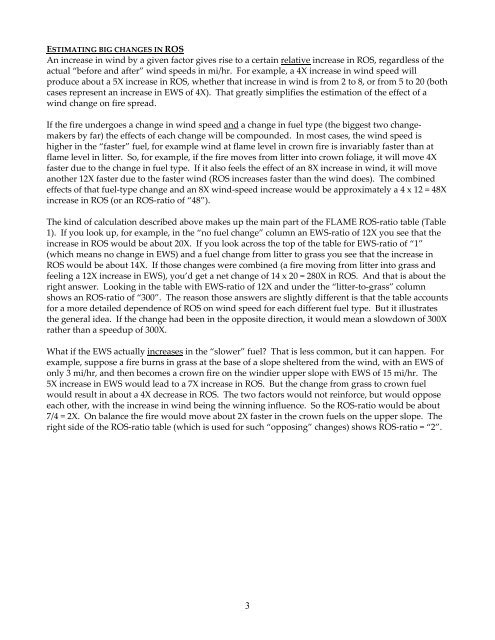FLAME in a Nutshell - NWCG Training and Qualifications
FLAME in a Nutshell - NWCG Training and Qualifications
FLAME in a Nutshell - NWCG Training and Qualifications
You also want an ePaper? Increase the reach of your titles
YUMPU automatically turns print PDFs into web optimized ePapers that Google loves.
ESTIMATING BIG CHANGES IN ROSAn <strong>in</strong>crease <strong>in</strong> w<strong>in</strong>d by a given factor gives rise to a certa<strong>in</strong> relative <strong>in</strong>crease <strong>in</strong> ROS, regardless of theactual “before <strong>and</strong> after” w<strong>in</strong>d speeds <strong>in</strong> mi/hr. For example, a 4X <strong>in</strong>crease <strong>in</strong> w<strong>in</strong>d speed willproduce about a 5X <strong>in</strong>crease <strong>in</strong> ROS, whether that <strong>in</strong>crease <strong>in</strong> w<strong>in</strong>d is from 2 to 8, or from 5 to 20 (bothcases represent an <strong>in</strong>crease <strong>in</strong> EWS of 4X). That greatly simplifies the estimation of the effect of aw<strong>in</strong>d change on fire spread.If the fire undergoes a change <strong>in</strong> w<strong>in</strong>d speed <strong>and</strong> a change <strong>in</strong> fuel type (the biggest two changemakersby far) the effects of each change will be compounded. In most cases, the w<strong>in</strong>d speed ishigher <strong>in</strong> the “faster” fuel, for example w<strong>in</strong>d at flame level <strong>in</strong> crown fire is <strong>in</strong>variably faster than atflame level <strong>in</strong> litter. So, for example, if the fire moves from litter <strong>in</strong>to crown foliage, it will move 4Xfaster due to the change <strong>in</strong> fuel type. If it also feels the effect of an 8X <strong>in</strong>crease <strong>in</strong> w<strong>in</strong>d, it will moveanother 12X faster due to the faster w<strong>in</strong>d (ROS <strong>in</strong>creases faster than the w<strong>in</strong>d does). The comb<strong>in</strong>edeffects of that fuel‐type change <strong>and</strong> an 8X w<strong>in</strong>d‐speed <strong>in</strong>crease would be approximately a 4 x 12 = 48X<strong>in</strong>crease <strong>in</strong> ROS (or an ROS‐ratio of “48”).The k<strong>in</strong>d of calculation described above makes up the ma<strong>in</strong> part of the <strong>FLAME</strong> ROS‐ratio table (Table1). If you look up, for example, <strong>in</strong> the “no fuel change” column an EWS‐ratio of 12X you see that the<strong>in</strong>crease <strong>in</strong> ROS would be about 20X. If you look across the top of the table for EWS‐ratio of “1”(which means no change <strong>in</strong> EWS) <strong>and</strong> a fuel change from litter to grass you see that the <strong>in</strong>crease <strong>in</strong>ROS would be about 14X. If those changes were comb<strong>in</strong>ed (a fire mov<strong>in</strong>g from litter <strong>in</strong>to grass <strong>and</strong>feel<strong>in</strong>g a 12X <strong>in</strong>crease <strong>in</strong> EWS), you’d get a net change of 14 x 20 = 280X <strong>in</strong> ROS. And that is about theright answer. Look<strong>in</strong>g <strong>in</strong> the table with EWS‐ratio of 12X <strong>and</strong> under the “litter‐to‐grass” columnshows an ROS‐ratio of “300”. The reason those answers are slightly different is that the table accountsfor a more detailed dependence of ROS on w<strong>in</strong>d speed for each different fuel type. But it illustratesthe general idea. If the change had been <strong>in</strong> the opposite direction, it would mean a slowdown of 300Xrather than a speedup of 300X.What if the EWS actually <strong>in</strong>creases <strong>in</strong> the “slower” fuel? That is less common, but it can happen. Forexample, suppose a fire burns <strong>in</strong> grass at the base of a slope sheltered from the w<strong>in</strong>d, with an EWS ofonly 3 mi/hr, <strong>and</strong> then becomes a crown fire on the w<strong>in</strong>dier upper slope with EWS of 15 mi/hr. The5X <strong>in</strong>crease <strong>in</strong> EWS would lead to a 7X <strong>in</strong>crease <strong>in</strong> ROS. But the change from grass to crown fuelwould result <strong>in</strong> about a 4X decrease <strong>in</strong> ROS. The two factors would not re<strong>in</strong>force, but would opposeeach other, with the <strong>in</strong>crease <strong>in</strong> w<strong>in</strong>d be<strong>in</strong>g the w<strong>in</strong>n<strong>in</strong>g <strong>in</strong>fluence. So the ROS‐ratio would be about7/4 = 2X. On balance the fire would move about 2X faster <strong>in</strong> the crown fuels on the upper slope. Theright side of the ROS‐ratio table (which is used for such “oppos<strong>in</strong>g” changes) shows ROS‐ratio = “2”.3
















